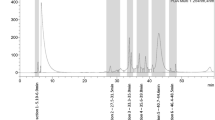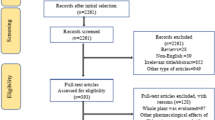Abstract
This study was performed to elucidate the anticancer mechanism of a lipid-soluble ginseng extract (LSGE) by analyzing induction of apoptosis and arrest of cell cycle progression using the NCI-H460 human lung cancer cell line. Proliferation of NCI-H460 cells was potently inhibited by LSGE in a dose-dependent manner. The cell cycle arrest at the G0/G1 phase in NCI-H460 cells was induced by LSGE. The percentage of G0/G1 phase cells significantly increased, while that of S phase cells decreased after treatment with LSGE. The expression levels of cyclin-dependent kinase2 (CDK2), CDK4, CDK6, cyclin D3 and cyclin E related to G0/G1 cells progression were also altered by LSGE. In addition, LSGE-induced cell death occurred through apoptosis, which was accompanied by increasing the activity of caspases including caspase-8, caspase-9 and caspase-3. Consistent with enhancement of caspase activity, LSGE increased protein levels of cleaved caspase-3, caspase-8, caspase-9, and poly-ADP-ribose polymerase (PARP). These apoptotic effects of LSGE were inhibited by the pan-caspase inhibitor Z-VAD-fmk. These findings indicate that LSGE inhibits NCI-H460 human lung cancer cell growth by cell cycle arrest at the G0/G1 phase and induction of caspase-mediated apoptosis.



Similar content being viewed by others
Abbreviations
- CDK:
-
cyclin-dependent kinase
- FITC:
-
fluorescein isothiocyanate
- LSGE:
-
lipid-soluble ginseng extract
- PARP:
-
poly-ADP-ribose polymerase
- XTT:
-
Sodium 3′-[1-(phenylaminocarbonyl)-3,4-tetrazolium]-bis (4-methoxy-6-nitro) benzene sulfonic acid hydrate
References
Helms S (2004) Cancer prevention and therapeutics: Panax ginseng. Altern Med Rev 9:259–274
Szeto YT, Wong JWM, Wong SCY, Pak SC, Benzie IFF (2011) DNA protective effect of ginseng and the antagonistic effect of Chinese turnip: a preliminary study. Plant Foods Hum Nutr doi:10.1007/s11130-011-0209-5
Roh YS, Kim HB, Kang CW, Kim BS, Nah SY, Kim JH (2010) Neuroprotective effects of ginsenoside Rg3 against 24-OH-cholesterol induced cytotoxicity in cortical neuron. J Ginseng Res 34:246–253
Kim YS, Kang KS, Kim SI (1990) Study on antitumor and immunomodulating activities of polysaccharide fractions from Panax ginseng: Comparison of effects of neutral and acidic polysaccharide fraction. Arch Pharm Res 13:330–337
Park EK, Choo MK, Han MJ, Kim DH (2004) Ginsenoside Rh1 possesses antiallergic and anti-inflammatory activities. Int Arch Allergy Immunol 133:113–120
Park SE, Park C, Kim SH, Hossain MA, Kim MY, Chung HY, Son WS, Kim GY, Choi YH, Kim ND (2009) Korean red ginseng extract induces apoptosis and decreases telomerase activity in human leukemia cells. J Ethnopharmacol 121:304–312
Oh M, Choi YH, Choi S, Chung H, Kim K, Kim SI, Kim DK, Kim ND (1999) Anti-proliferating effects of ginsenoside Rh2 on MCF-7 human breast cancer cells. Int J Oncol 14:869–875
Yun TK (2003) Experimental and epidemiological evidence on non-organ specific cancer preventive effect of Korean ginseng and identification of active compounds. Mutat Res 523–524:63–74
Matsunaga H, Katano M, Yamamoto H, Fujito H, Mori M, Takata K (1990) Cytotoxic activity of polyacetylene compounds in Panax ginseng C. A. Meyer. Chem Pharm Bull 38:3480–3482
Lee SD, Yoo G, Chae HJ, In MJ, Oh NS, Hwang YK, Hwang WI, Kim DC (2009) Lipid-soluble extracts as the main source of anticancer activity in ginseng and ginseng marc. J Am Oil Chem Soc 86:1065–1071
Kim JY, Lee KW, Kim SH, Wee JJ, Kim YS, Lee HJ (2002) Inhibitory effect of tumor cell proliferation and induction of G2/M cell cycle arrest by panaxytriol. Planta Med 68:119–122
Park CE, Baek N, Park C (2001) Extraction of panaxynol and panaxydol compounds from Korean ginseng. Biotechnol Bioprocess Eng 6:433–437
Lee SD, Park SK, Lee ES, Kim HM, Lee CW, Lee K, Lee KH, Kang MR, Lee KS, Lee J, Hwang WI, Kim DC (2010) A lipid-soluble red ginseng extract inhibits the growth of human lung tumor xenografts in nude mice. J Med Food 13:1–5
Lee ES, Kim HM, Lee SD, Lee KS, Park SG, Lee CW, Lee K, Lee KH, Lee J, Hwang WI, In MJ, Kim DC (2010) A lipid-soluble ginseng extract inhibits human large cell lung cancer (NCI-H460) cells xenograft in vivo and the proliferation of cancer cells in vitro. J Korean Soc Appl Biol Chem 53:375–378
Kim DC, Lee JY, In M, Chae HJ, Hwang YK, Hwang WI (2001) Effects of polyacetylenes in ginseng on activity of enzymes related to post-translational modification of ras protein and effects of petroleum ether extract of ginseng on progression of cell cycle. J Ginseng Res 25:156–161
Fisher D (1994) Apoptosis in cancer therapy: Crossing the threshold. Cell 78:539–542
Hu H, Ahn NS, Yang X, Lee YS, Kang KS (2002) Ganoderma lucidum extract induces cell cycle arrest and apoptosis in MCF-7 human breast cancer cell. Int J Cancer 102:250–253
Carney DN (2002) Lung cancer-time to move on from chemotherapy. N Engl J Med 346:126–128
Voortman J, Checinska A, Giaccone G, Rodriguez JA, Kruyt FAE (2007) Bortezomib, but not cisplatin, induces mitochondria-dependent apoptosis accompanied by up-regulation of noxa in the non-small cell lung cancer cell line NCI-H460. Mol Cancer Ther 6:1046–1053
Abdullah S, Abidin SAZ, Murd NA, Makpol S, Ngah WZW, Yusof YAM (2010) Ginger extract (Zingiber officinale) triggers apoptosis and G0/G1 cells arrest in HCT 116 and HT 29 colon cancer cell lines. Afr J Biochem 4:134–142
Wang CY, Lin KH, Yang CJ, Tsai JR, Hung JY, Wang PH, Hsu HK, Huang MS (2010) Toona sinensis extracts induced cell cycle arrest and apoptosis in the human lung large cell carcinoma. Kaohsiung J Med Sci 26:68–74
Evrone E, Umbrichi CB, Korz D, Raman V, Loeb DM, Niranjan B, Marks J, Sukumar S (2001) Loss of cyclin D2 expression in the majority of breast cancer is associated with promoter hypermethylation. Cancer Res 61:2782–2787
Jeong HW, Lee HJ, Kho YH, Son KH, Han MY, Lim JS, Lee MY, Han DC, Ha JH, Kwon BM (2002) Biological effects of G1 phase arrest compound, sesquicillin, in human breast cancer cell lines. Bioorg Med Chem 10:3129–3134
Pyo JS, Ju HK, Park JH, Kwon SW (2008) Determination of volatile biomarkers for apoptosis and necrosis by solid-phase microextractoion-gas chromatography/mass spectrometry: A pharmacometabolomic approach to cisplatin’s cytotoxicity to human lung cancer cell lines. J Chromatogr B 876:170–174
Betz N, Farfan A, O’Brien M (2003) Detecting caspase activity in staurosporine-treated human neuroblastoma cells using fluorescent and luminescent methods. Cell Notes 7:9–11
Kim KS, Phee KH, Yoon JH, Lee JG, Lee JH, Yoo JB (2005) Gingko biloba extract (EGb 761) induces apoptosis by the activation of caspase-3 in oral cavity cancer cells. Oral Oncol 41:383–389
Nicholson DW (2000) From bench to clinic with apoptosis-based therapeutic agents. Nature 407:810–816
Yasmin AMY, Shahriza ZA, Looi ML, Shafina HMH, Harlianshah H, Noor AAH, Suzana M, Wan ZWN (2008) Ginger extract (Zingiber officinale Roscoe) triggers apoptosis in hepatocarcinogenesis induced rats. Med Health 3:263–274
Catalano MG, Fortunati N, Pugliese M, Costantino L, Poli R, Bosco O, Boccuzzi G (2005) Valproic acid induces apoptosis and cell cycle arrest in poorly differentiated thyroid cancer cells. J Clin Endocrinol Metab 90:1383–1389
Cao P, Cai X, Lu W, Zhou F, Huo J (2011) Growth inhibition and induction of apoptosis in SHG-44 giloma cells by Chinese medicine formula “Pingliu Keli”. Evid Based Complement Alternat Med doi:10.1155/2011/958243
Beevi SS, Mangamoori LN, Subathra M, Edula JR (2010) Hexane extract of Raphanus sativus L. roots inhibits cell proliferation and induces apoptosis in human cancer cells by modulating genes related to apoptotic pathway. Plant Foods Hum Nutr 65:200–209
Acknowledgements
This study was supported in part by a grant (No. A101836) of the Korean Health Technology R&D Project, Ministry for Health, Welfare & Family Affairs, Republic of Korea and a grant from the KRIBB Research Initiative Program.
Conflicts of Interest
There are no actual conflicts of interest.
Author information
Authors and Affiliations
Corresponding authors
Additional information
Moo Rim Kang and Hwan Mook Kim contributed equally to this work.
Rights and permissions
About this article
Cite this article
Kang, M.R., Kim, H.M., Kang, J.S. et al. Lipid-Soluble Ginseng Extract Induces Apoptosis and G0/G1 Cell Cycle Arrest in NCI-H460 Human Lung Cancer Cells. Plant Foods Hum Nutr 66, 101–106 (2011). https://doi.org/10.1007/s11130-011-0232-6
Published:
Issue Date:
DOI: https://doi.org/10.1007/s11130-011-0232-6




